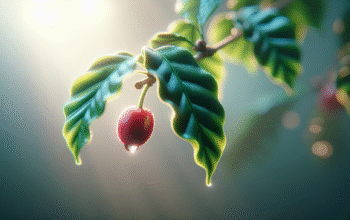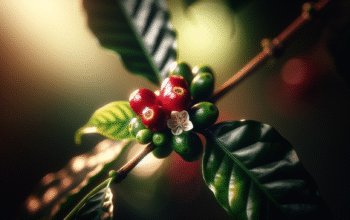Have you ever wondered what makes Coffea racemosa distinct from the coffee you usually drink and why it matters for coffee diversity and conservation?

About Coffea racemosa
Coffea racemosa is one of the lesser-known wild coffee species native to southern Mozambique and nearby parts of southern Africa. As you read, you’ll encounter details that show why this species is botanically interesting, agriculturally relevant, and increasingly important for conservation and specialty coffee markets.
Origins and history
You’ll find that Coffea racemosa has a specific geographic and cultural background that shapes its biology and current status.
Taxonomy and classification
Coffea racemosa belongs to the genus Coffea in the Rubiaceae family. It is one of more than 120 Coffea species, though just a handful are commonly cultivated for commercial coffee production. Taxonomically, racemosa is distinct from Coffea arabica and Coffea canephora (robusta), and its genetic differences are of interest to researchers exploring disease resistance and climate adaptability.
Geographic distribution
Coffea racemosa is native mainly to southern Mozambique and the coastal regions of adjacent countries. You can find it in lowland forest patches, coastal scrub, and some riverine habitats where conditions remain relatively humid despite the generally warmer climate of the region.
Historical context
Local communities historically used racemosa beans for subsistence consumption and occasional trade. It was never cultivated on the same large scale as arabica or robusta, which is part of why it remained less known internationally until recent interest from researchers and specialty coffee enthusiasts.
Botanical characteristics
Understanding the plant’s physical traits helps you recognize its strengths and limitations for cultivation and conservation.
Plant morphology
Coffea racemosa typically grows as a small tree or large shrub, often reaching heights between 1.5 and 6 meters depending on growing conditions. Its leaves are relatively small and thin compared with arabica, and it bears small clusters of flowers followed by small cherry-like fruits.
Flowering and fruiting
Flowers are white and fragrant, appearing in clusters. Fruit (the coffee cherry) is small and contains one or two seeds (beans). The relatively small berry and bean size contribute to lower yield per tree compared with arabica and robusta.
Genetics and chromosome count
Coffea racemosa is diploid, with a chromosome number distinct from the allotetraploid arabica (which has arisen from hybridization between other species). Its genetic makeup provides potential traits—such as drought tolerance—that breeders may consider when searching for resilience traits to introduce into cultivated varieties.
Cultivation and agronomy
If you’re considering growing racemosa or evaluating it for a project, these agronomic details will help you plan.
Growing conditions
Racemosa favors warm, low-elevation climates and tolerates coastal conditions better than many other Coffea species. You’ll want to aim for environments that do not experience severe cold and that provide some shade and consistent humidity.
Soil and climate
This species prefers well-draining soils with moderate organic matter. It tolerates a wider range of soil pH than arabica, but consistently waterlogged or extremely alkaline soils will reduce performance. You’ll notice better health in regions with moderate humidity and stable temperatures.
Propagation and planting
You can propagate racemosa from seed or cuttings. Seeds germinate more slowly than some cultivated varieties; fresh seed viability is important, so you’ll want to sow promptly or use appropriate seed storage techniques. Vegetative propagation via cuttings or grafting onto compatible rootstocks is possible and useful if you want to replicate desirable traits.
Pests and diseases
While racemosa shows resilience to some pests and diseases, it is not immune. You’ll need to monitor for common coffee pests such as leaf rust, scale, and various borers. Some reports suggest racemosa may have relative tolerance to certain pathogens compared with arabica, but this varies by local conditions and specific pathogen pressures.
Harvesting practices
Beans ripen unevenly on racemosa plants, and harvest is often selective by hand to capture the ripest cherries. Because yields are lower and cherries smaller, careful manual harvesting is the most common approach. You’ll want to train harvesters to recognize optimal ripeness to ensure flavor quality.
Growth requirements at a glance
| Requirement | Details |
|---|---|
| Elevation | Typically lowland to mid-elevation (coastal areas preferred) |
| Temperature range | Warm-tropical, generally 18–28°C (64–82°F) optimal |
| Rainfall | Moderate humidity with seasonal rain; avoid prolonged drought |
| Soil | Well-draining, moderate organic matter; tolerant of varied pH |
| Shade | Partial shade recommended for leaf health and microclimate |
| Propagation | Seed (fresh) or vegetative (cuttings/grafting) |
| Harvesting | Handpicking of ripe cherries due to small size and low yield |
Processing and post-harvest
Processing choices significantly affect the eventual cup profile, and racemosa’s small cherries require careful handling.
Harvest timing and initial handling
You’ll want to process cherries as soon as possible after harvest to avoid fermentation or spoilage. Because the cherries are small and often harvested by hand, sorting to remove unripe or overripe fruit is an important step.
Processing methods
Common methods you can use include natural (dry) processing, washed (wet) processing, and variations like pulped natural. Each method influences sweetness, acidity, and body in the cup.
- Natural: Whole cherries are dried intact, which tends to enhance sweetness and fruity aromas. For racemosa, naturals can produce intense, sometimes unusual fruit notes if drying is controlled carefully.
- Washed: Pulping and fermenting to remove mucilage before drying tends to emphasize clarity and acidity. Washed racemosa offers cleaner flavor lines, though careful fermentation control is vital because small cherries can over-ferment quickly.
- Semi-washed/pulped natural: Offers a middle ground, preserving some fruit sugars while reducing potential off-flavors from long fermentation.
Drying and storage
You’ll need to dry beans to safe moisture levels (typically 10–12%) using raised beds or patios, keeping an eye on humidity and temperature to avoid mold. Due to small seed size, drying curves can differ from arabica; you’ll want slower, even drying to preserve delicate aromatics. After drying, store green beans in cool, dry conditions and monitor for pests.
Processing methods comparison
| Method | Typical effect on flavor | Best when |
|---|---|---|
| Natural (dry) | Enhanced sweetness, fruit-forward, heavier body | You can control drying speed; low humidity |
| Washed (wet) | Cleaner cup, brighter acidity, more clarity | You have good fermentation control and water resources |
| Pulped natural | Balanced sweetness and clarity | You want complexity with less risk of over-fermentation |
Flavor profile and sensory attributes
The cup of racemosa can surprise you with its unique sensory signature. It often differs significantly from arabica and robusta offerings.
Green bean characteristics
Green racemosa beans are small and dense, which affects roasting dynamics. You’ll notice lower overall bean mass and different heat transfer during roasting, requiring adjustments in roast profiles.
Roasting considerations
Because beans are small and can heat quickly, you’ll want to roast cautiously: medium to light roast profiles often highlight floral, citrus, and sweet fruit notes. Over-roasting can obscure subtleties and produce harsh or flat flavors. You’ll need to experiment with charge temperature, development time, and airflow to find the sweet spot.
Taste and aroma
Many tasters describe racemosa coffee as having delicate acidity, floral or tea-like notes, and subtle fruit sweetness. Body may be lighter than arabica, and bitterness tends to be lower. You’ll often detect notes like citrus blossom, green tea, honey, and, in naturals, tropical fruit. Individual lots vary widely based on processing and terroir.
Typical sensory descriptors
| Attribute | Common description |
|---|---|
| Acidity | Bright but gentle, citrus or tea-like |
| Body | Light to medium |
| Sweetness | Honeyed or floral sweetness |
| Aromas | Floral, herbal, citrus blossom, light fruit |
| Aftertaste | Clean and lingering with delicate floral notes |
Comparisons with Arabica and Robusta
When you compare racemosa to the mainstream species, the differences become clearer: arabica generally shows higher acidity and wider flavor complexity; robusta offers heavier body and bitterness with more caffeine. Racemosa tends to be lighter-bodied and more floral, often closer to tea-like in character.
| Species | Body | Acidity | Common notes | Caffeine |
|---|---|---|---|---|
| Coffea arabica | Medium | Higher, nuanced | Floral, fruity, chocolate, complex | Moderate |
| Coffea canephora (robusta) | Full | Lower/sharp | Earthy, woody, bitter | Higher |
| Coffea racemosa | Light–medium | Bright but gentle | Floral, tea-like, honeyed, citrus | Lower than robusta, variable |

Brewing recommendations
To get the most from racemosa, you’ll want to tailor your brewing approach to its unique characteristics.
Grind and extraction
Because the beans are small and denser, adjust grind finer than you would for the same roast level of arabica. However, extraction should be careful to avoid over-extracting bitter or astringent compounds. Start with a medium-fine grind for pour-over and slightly coarser for immersion methods.
Brewing methods that suit racemosa
- Pour-over (V60, Kalita): Great for highlighting clarity and delicate floral notes. Use medium flow and gentle pours.
- Aeropress: Offers control and can bring out sweetness while keeping body moderate.
- Cold brew: Produces a smooth, mellow cup that emphasizes sweetness and reduces perceived acidity. Cold brew can be excellent if you want a less delicate profile.
- French press: Can emphasize body more than other methods; use a slightly coarser grind and shorter steep time to avoid muddiness.
Suggested ratios and parameters
These are starting points; adjust to taste.
- Pour-over: 1:15 to 1:16 coffee-to-water, water 92–96°C (197–205°F), brew time 2.5–3.5 minutes.
- Aeropress: 1:12 to 1:15, water 90–94°C (194–201°F), 1–2 minutes immersion.
- Cold brew: 1:4 concentrate steeped 12–18 hours at room temperature or refrigerated; dilute to taste.
- French press: 1:12, 4 minutes steep at 93–96°C (199–205°F), plunge slowly.
Serving suggestions
You’ll find racemosa delightful as a simple pour-over to appreciate its floral notes, but it can also create interesting milk-based drinks if lightly roasted—it pairs well with milk’s sweetness without being overpowered.
Conservation status and threats
If you care about the future of coffee diversity, racemosa is a species you’ll want to understand and support.
IUCN status and assessments
Coffea racemosa has been assessed as having a conservation concern in parts of its range because of habitat fragmentation and limited distribution. You’ll find that its wild populations are localized and vulnerable to multiple pressures, which raises conservation flags.
Primary threats
- Habitat loss: Coastal development, agriculture expansion, and deforestation reduce available habitat.
- Climate change: Shifts in rainfall patterns and increasing temperatures can stress populations adapted to narrow environmental windows.
- Overharvesting: Although not widely harvested commercially, local pressure and opportunistic exploitation can reduce wild populations.
- Genetic erosion: Small, fragmented populations can lose genetic diversity, reducing adaptive potential.
Conservation initiatives
You’ll encounter various in-situ and ex-situ strategies aimed at preserving racemosa:
- Protected areas and community-managed reserves to secure habitat.
- Seed banks and living collections in botanical gardens for genetic backup.
- Participatory conservation with local communities linking sustainable use to livelihood benefits.
- Research projects assessing genetic diversity and adaptive traits to support breeding programs.
How you can help
If you’re involved in coffee sourcing, research, or conservation, you can contribute by supporting projects that:
- Fund local conservation and restoration efforts.
- Purchase beans from ethical sources that invest in habitat protection.
- Encourage research into racemosa’s genetics and agronomic potential.
- Promote ex-situ conservation through seed banking and living collections.
Economic and cultural importance
Racemosa’s role in local economies and its potential on the global market deserve attention if you’re thinking about sustainable development or specialty coffee ventures.
Local uses and cultural significance
Local communities have used racemosa for traditional beverages and sometimes medicinal purposes. Cultural knowledge about the plant can support conservation and sustainable harvest practices if you engage respectfully with those communities.
Market potential and challenges
Specialty coffee interest has introduced racemosa to niche markets, where its unique flavor profile can command premium prices. However, challenges include low yields, small beans that complicate processing and roasting, and the need for consistent supply chains. If you’re considering commercial work, you’ll need to balance ethical sourcing with careful agronomic planning.
Value chain considerations
You’ll find that developing a racemosa value chain requires training in harvest, processing, and post-harvest handling to meet specialty standards. Investing in farmer training, processing infrastructure, and transparent marketing can help create sustainable livelihoods for producers while preserving wild populations.
Research and future directions
There’s growing scientific and commercial interest in racemosa as part of broader efforts to diversify coffee genetics and build resilience into the coffee sector.
Breeding potential and resilience traits
Researchers are examining racemosa for traits such as heat and drought tolerance, pest and disease resistance, and unique flavor compounds. You may find racemosa useful in breeding programs aiming to introduce resilience without compromising cup quality.
Hybridization and inter-species crosses
While interbreeding across Coffea species can be complex, you might encounter research exploring hybrids and genetic introgression as ways to broaden the adaptive toolbox for coffee. Any hybrid development must consider agronomic performance, cup quality, and the ethics of using wild genetic resources.
Opportunities for agronomy and sensory research
You can support or follow studies that assess optimal agronomic practices, processing approaches, and roasting profiles tailored to racemosa. Sensory analysis and consumer testing will inform how best to position this coffee in markets while maintaining cultural and ecological integrity.
Practical tips for growers and roasters
If you’re working hands-on with racemosa, these actionable tips can save time and improve results.
For growers
- Prioritize shade trees and soil organic matter to maintain microclimate and moisture.
- Use selective harvest methods to pick ripe cherries and avoid mixing maturity levels.
- Implement simple drying infrastructure (raised beds) to control drying rates and avoid mold.
- Monitor pests regularly and use integrated pest management to reduce chemical reliance.
- Consider establishing living seed collections and local nurseries to maintain genetic diversity.
For processors and roasters
- Start with small trial batches to find ideal processing and roast profiles.
- Use low and slow roast approaches early on to preserve floral and tea-like notes.
- Adjust grind and extraction parameters to account for small bean size and density.
- Keep excellent traceability records so you can associate processing variables with cup outcomes.
Frequently asked questions
You’ll likely have practical questions; here are answers to common ones.
Is Coffea racemosa caffeine-free?
No, racemosa is not caffeine-free, but its caffeine content is generally lower than robusta and variable compared with arabica. It’s not an alternative for caffeine-free needs unless specifically processed or blended with decaf.
Can racemosa be grown commercially like arabica?
In principle, yes, but there are hurdles. Lower yields, small bean size, and niche market demand mean commercial viability depends on specialty positioning, careful agronomy, and value-added processing. Community-based, small-lot production tends to work best initially.
Is racemosa resistant to coffee leaf rust (Hemileia vastatrix)?
Racemosa may show varying susceptibility to common coffee diseases. Some sources suggest relative tolerance to certain pathogens, but you should not assume full resistance. Local testing and integrated pest management remain essential.
Where can I buy racemosa coffee?
Your best chances are specialty coffee roasters, producers in Mozambique and southern Africa offering single-origin lots, or conservation-linked projects. Look for sellers who provide traceability and information about sustainable sourcing.
Ethical and social considerations
You’ll want to approach racemosa work with sensitivity to social and environmental impacts.
Benefit sharing and intellectual property
If you use racemosa genetics in breeding or commercialization, make sure benefits are shared equitably with source communities and that local rights are respected. Adhering to frameworks such as the Nagoya Protocol and community consent processes is important.
Community engagement
Work that supports local livelihoods, respects traditional knowledge, and involves communities in decision-making will help both conservation and social outcomes. You’ll get better results when local stakeholders are partners rather than passive suppliers.
Summary and next steps
Coffea racemosa offers a fascinating mix of botanical uniqueness, delicate cup characteristics, and conservation importance. If you care about coffee diversity, resilient agroecosystems, or creating distinctive specialty coffees, racemosa can be part of the solution—but it requires thoughtful agronomy, careful processing, ethical sourcing, and conservation-minded partnerships.
If you want to take action, consider:
- Supporting conservation projects in southern Africa.
- Partnering with researchers or roasters doing small-lot racemosa work.
- Promoting traceability and benefit-sharing in any commercial ventures.
- Learning more about Coffea species diversity to encourage resilient coffee systems.
Final thoughts
You’re looking at more than another coffee species: Coffea racemosa stands at the intersection of biodiversity, culture, and specialty beverage potential. Whether you’re a grower, roaster, researcher, or conscious consumer, your choices can help preserve this species and the ecosystems and people connected to it while bringing unique flavors to the cup.



